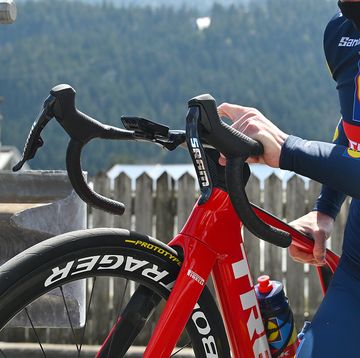We recently learned of a massive—by cycling standards—recall of Shimano Ultegra and Dura-Ace cranks. It affects about 780,000 cranks sold in the USA and Canada, of which the CPSC says there are reports of over 4,500 failures.
So far, this recall only applies to the North American market. Information about what actions other regions will take (and how many more cranks are affected) is not yet available. But it is safe to assume that the worldwide total of the problematic cranks in question is far more than 780,000 (I’ve heard upwards of 2.8 million cranks).
Evidence of these failures is abundant on the internet and existed for years. It’s essentially the entire basis of the Instagram account @ThanksShimano. I’m glad this situation is getting addressed while simultaneously annoyed it took so long. But CPSC recalls often take a frustratingly long time to enact.
Recalls are always bad. But speaking from my experience and position, they’re not unexpected.
Enthusiast cycling equipment—the high-end stuff in particular—always pushes limits. Usually weight. Cycling’s maniacal obsession with lightweight equipment pushes brands to continuously strive to build lighter products while simultaneously chasing stiff and beautiful (because almost every bicycle part is visible).
Couple the demand for lightweight gear with the (justifiable) screaming accompanying the spiraling costs of cycling equipment, and the drumbeat becomes: Lighter but also cheaper.
That’s not the most fertile environment for conservatively designed cycling components emphasizing reliability and longevity.
However, the demand for lighter weights and higher performance often results in amazing equipment. Take the new Specialized S-Works Tarmac SL8 I reviewed recently. It has disc brakes, 24-speed electronic shifting, tubeless wheels and tires, a power meter, and aerodynamic tuning to save watts. It’s ferociously stiff yet smooth as glass and handles like a dream.
The Tarmac is all that and weighs about 14.5 pounds.
I’ve had cats that weigh about 14.5 pounds. The Kitchen Aid stand mixer in my pantry weighs almost 27 pounds. 14.5 pounds is nothing.
I’m still amazed that bikes can offer so much yet weigh this little.
I’ve descended hills at nearly 60 miles an hour on this Tarmac, sprinted for all my worth on it, and slammed it through corners. I’ve done all that basically naked with a glorified beer koozie on my head. And yet, I fully trust this Tarmac. And I’ve not thought twice before diving into a downhill corner at high speed with cars and trucks around me.
Maybe I should be more worried. I often fret that our demands as cycling enthusiasts encourages brands to develop equipment that isn’t safety-first. Even so, I believe (hope?) that, overall, the majority of the stuff I ride—that we ride—is safe when used and cared for properly.
Still, bike parts break in ways that can lead to injury or worse. Parts failures due to manufacturing or design deficiencies should not happen. Ever. Overall, I consider myself lucky: In over 20 years on this job—often riding prototype and pre-production parts—I’ve only experienced a few JRA (just riding along) failures.
Some of the more notable: I had a carbon head tube shear just above the headset skirt, I had a steel frame buckle, I snapped a carbon handlebar, I had a pedal axle fail, I’ve had tires suddenly fail or blow off the rim, I pulled apart a chain while sprinting, and I’ve snapped a few suspension linkages.
I can’t say all those failures were due to material, manufacturing, or design problems and not things like over-stressing parts, other mechanic’s or rider’s mistakes, or unknown damage picked up during normal use.
But when companies push the limits of weight, materials, or manufacturing methods in pursuit of making (and selling) parts they think riders want—or, perhaps, to create “winning” marketing highlights—there is often less margin for error. And less of a safety net built into the parts. Parts that are fine if always used and cared for exactly right—but introduce one little mistake or whisp of human error, and the time bombs start ticking.
What ties all the failures I’ve experienced is how terrifyingly helpless I felt when the parts failed and that I’m fortunate that I escaped the situations with little injury. But other riders weren’t so lucky. According to the CPSC’s information page on the Shimano crank recall, people experienced “Six reported injuries, including bone fractures, joint displacement and lacerations.”
But even with these failures, I believe the stuff we ride today is far more reliable than the stuff we rode in the 1990s.
Ask anyone who lived through the mountain bike boom of the 1990s—I’m one of them—and they’re likely to have many stories about how impressively unreliable the bikes and parts were. I’m certain there are still shards of Grafton and Kooka cranks littering trails around the world.
Around the same time that mountain bikes were heaps of beautifully machined and anodized junk was the age of sub-1,000 gram “throwaway” aluminum road frames. It served as the transition between the steel and carbon eras. But it was the stuff of nightmares.
Thankfully, these bikes and parts are in our rearview. Mountain bikers, especially, are riding faster, jumping and dropping further, and riding more technical trails. And yet, the equipment is more reliable than ever. Road bikes toe or fall below the UCI’s weight limit and yet have more features, performance, and reliability than ever.
Even so, I’m not usually surprised when a recall of a cycling product occurs. But I do find the Shimano crank recall somewhat stunning.
The brand is known for its conservative designs. They’re not usually the first (or tenth) brand that comes to mind when you think of boundary-pushing parts. It is a company that, even in 2023, hardly uses any carbon fiber in its drivetrains. Shimano often takes a maddeningly long time to react to market demands like 1x drivetrains.
The cranks that are the subject of the recall are 600-gram-plus forged aluminum cranks with steel axles. They’re not hyperlight exotic stuff like a 300-gram THM Clavicula carbon crank.
While presented as a recall of Shimano’s HollowTech II cranks, that's not the entire story. HollowTech II was introduced in 2005 and it’s used on a great variety of Shimano’s cranks. Significantly, many mountain bike cranks like XTR and XT—off-road analogues of Dura-Ace and Ultegra—as well as the Saint cranks intended for downhill, park, and freeride use, and the DXR BMX racing cranks. Plus, 105 and GRX cranksets.
But though all those cranks are HollowTech II, not all of them use the forged then bonded construction technique that appears to be the heart of the issue here. And it’s not even all Shimano bonded cranks: “Only” those manufactured between June 1, 2012, to June 30, 2019.
But obviously, something happened. Bad design? Poor quality control? Errors in manufacturing? Bad batch of materials? Or something else?
Whatever the reason(s), hopefully, Shimano figured them out and addressed them. And all the bonded HollowTech II cranks that aren’t part of the recall—including the latest Dura-Ace, and Ultegra—will never have the same problems.
I don’t want to excuse an obviously unacceptable situation, but I do think it’s important to remember the scale. Shimano manufactures a LOT of cranks. Consider that the recall covers about 680,000 Ultegra and Dura-Ace cranks sold in the USA only, plus another 80,000 in Canada.
Now imagine the number of Ultegra and Dura-Ace cranks sold in other countries and it’s clear that Shimano manufactures a boggling number of high-end cranks. In the seven years of production the recall covers, I’ve heard that Shimano produced 2.8 million Dura-Ace and Ultegra cranks. Which means Shimano is looking at a significant hit to their bottom line for all the replacements, and the inevitable lawsuits.
And yes, I’m as surprised as many of you to realize how many Dura-Ace and Ultegra equipped—the high-end stuff—bikes get sold around the world. And that’s not counting high-end Dura-Ace and Ultegra equipped bikes with Cannondale HollowGram, Specialized S-Works, FSA, Rotor, or another crankset in place of Shimano’s.
Doing a little math on the numbers in the CPSC announcement, 4,519 cranks—the number of reported failures—is 0.59 percent of 780,000. However, we can assume that not all failures are reported. So, let’s double the failures to 9,000: that’s 1.18 percent. 15,000 failures would be 1.92 percent. Big numbers, but a low percentage.
No failures are good, but is a sub-two percent failure rate of a mass-produced product bad? As is often the case, it depends on who you ask.
One manufacturing expert in the cycling industry contacted by Bicycling commented, “Honestly, I think they’re well within failure range. If you put it against other failure rates and safety factors for everyday items, they’re incredibly safe. Like really, really, safe statistically.”
That’s one expert’s opinion. Another manufacturing expert I consulted stated that even one failure out of 1000 is unacceptable.
There will never be a perfect product. Every product manufactured at scale has an acceptable quality limit. Whenever you buy a product, it’s a game of chance: Will you get one of the good ones or one of the potentially defective ones? Thankfully, you’re statistically more likely to get the former and not the latter.
I’m not sure what lessons we can learn from this recall other than it is more proof that any product can fail, even those made by conservative companies. And that, as riders, we should always be on guard. We should closely inspect our gear (often and especially if it is super light), always take good care of our stuff (use a torque wrench!), and use products in the manner they were intended.
And we should look out for each other by letting the world know when products fail. Social media, for all its many foibles, gets huge credit for documenting and drawing attention to clearly problematic Shimano cranks.
All cycling gear can fail. But it is the responsibility of all of us—the riders and the brands that make the products—to ensure that it happens as little as possible and that defective parts are identified promptly and rectified properly.

A gear editor for his entire career, Matt’s journey to becoming a leading cycling tech journalist started in 1995, and he’s been at it ever since; likely riding more cycling equipment than anyone on the planet along the way. Previous to his time with Bicycling, Matt worked in bike shops as a service manager, mechanic, and sales person. Based in Durango, Colorado, he enjoys riding and testing any and all kinds of bikes, so you’re just as likely to see him on a road bike dressed in Lycra at a Tuesday night worlds ride as you are to find him dressed in a full face helmet and pads riding a bike park on an enduro bike. He doesn’t race often, but he’s game for anything; having entered road races, criteriums, trials competitions, dual slalom, downhill races, enduros, stage races, short track, time trials, and gran fondos. Next up on his to-do list: a multi day bikepacking trip, and an e-bike race.















